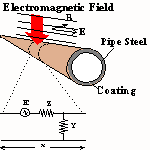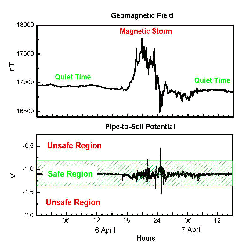| GSP Study Archive |
|---|
| Space Weather Studies |
| Applications Pilot Project |
| Feasibility Studies |
| CDF Space Weather Study |
| Past Workshops |
| Past Publications |
Pipeline SWS
Space Weather Service for Pipelines
Developer
NRCan
Technical Group
GIC & Ground Effects
SDA objective
To provide the pipeline industry with information on geomagnetic and telluric current activity and possible effects on corrosion protection systems.
Geomagnetic disturbances, produced by active space weather periods, have two major effects on pipeline performance 1. Corruption of the cathodic protection survey data 2. Reduction of the expected lifetime of the pipelines.
Products
Geomagnetic field variations at the geomagnetic observatory closest to the pipeline location.
Geo-electric (telluric) field variations, determined by converting the magnetic field data to the electric field using one-dimensional layered earth conductivity model.
Pipe-to-soil potential difference (PSP) variations for a sample pipeline, obtained by applying the distributed source transmission line model (DSTL) for simple pre-defined pipeline topologies with the geo-electric field as a driving source.
PSP variations for user-defined pipeline topologies are also available.
Link to Project WebSite
SDA description
Gas and oil pipelines are made from of steel covered with layers of special isolating coating. Through defects in the coating, the pipeline steel comes in contact with the soil, water or moist air and becomes subject to corrosion.
Corrosion is the oxidation reaction dependent on the electrochemical condition at the surface of the steel. A cathodic protection system keeps the pipeline potential with respect to the soil in a safe range from -0.85V to -1.35V to inhibit the oxidation reaction of pipeline steel.
Main problems and our solutions
1. Fluctuations of pipe-to-soil potential (PSP) on oil and gas pipelines due to geomagnetic activity have been observed by corrosion control personnel when conducting routine control surveys. The common practice was to discontinue the survey until the geomagnetic storm finished. Provision of on-line information on the current and expected geomagnetic conditions will benefit the planning and performance of cathodic protection surveys. See the short and long term forecasts of the geomagnetic conditions at different areas of Canada at http://www.spaceweather.gc.ca/.
2. PSP fluctuations due to the telluric currents constantly affect the accuracy of pipe-to soil potential measurements. Temporary surveys shutdowns cannot satisfy the more important concerns of pipeline engineers on the quality and accuracy of cathodic protection.Modelled pipe-to-soil potential difference for the pipeline measuring sites at the time of cathodic protection surveys will help in interpretation of PSP data.
Contact / Manager
Dr Larisa Trichtchenko| Address: | Geomagnetic Lab 7 Observatory Crescent Ottawa, Ontario K1A 0Y3 Canada |
| E-mail: | ltrichtc@nrcan.gc.ca |
| Telephone: | 1-613-837-9452 |
| Telefax: | 1-613-824-9803 |


